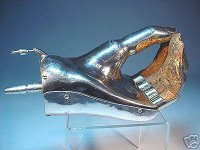 You know, based on some of the things I see, there are times I wonder just which is the smartest creature on the planet.
You know, based on some of the things I see, there are times I wonder just which is the smartest creature on the planet.Take, for example, the dog Ginny who just died in August. If you believe only half of what you hear, Ginny was quite an intelligent animal. Not only did she rescue other animals in distress, those animals were cats. In fact, she is credited with rescuing nearly 900 (!) cats during her 17-year life.
Such an extraordinary animal was she that, in 1998, the Westchester Cat Show (NY) named her Cat of the Year.
You can find out more at the official Ginny Fan Club site which contains many stories of the work done by this wonderful animal. (You might wish to have a box of tissue handy.)
There is also information about the Ginny Fund, which collects money to continue her work helping animals in need.
Photo of Ginny and two of her rescues used with kind permission of the site webmaster. Copyright Philip Gonzalez, caretaker of Ginny.
Disclaimer: I have no relationship at all with the Ginny Fan Club or the Ginny Fund.




